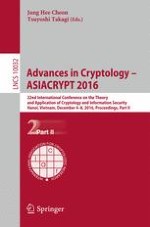2016 | OriginalPaper | Buchkapitel
Size-Hiding Computation for Multiple Parties
verfasst von : Kazumasa Shinagawa, Koji Nuida, Takashi Nishide, Goichiro Hanaoka, Eiji Okamoto
Erschienen in: Advances in Cryptology – ASIACRYPT 2016
Verlag: Springer Berlin Heidelberg
Aktivieren Sie unsere intelligente Suche, um passende Fachinhalte oder Patente zu finden.
Wählen Sie Textabschnitte aus um mit Künstlicher Intelligenz passenden Patente zu finden. powered by
Markieren Sie Textabschnitte, um KI-gestützt weitere passende Inhalte zu finden. powered by
